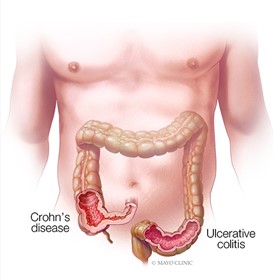May is the national Crohn’s and Colitis Awareness Month. Crohn’s disease and ulcerative colitis are collectively known as inflammatory bowel disease (IBD). More than 75000 Australians are currently living with Crohn’s disease or ulcerative colitis.
The key difference between the 2 conditions is that Crohn’s disease can appear in any part of a person’s digestive tract causing inflammation to the full thickness of the bowel anywhere from mouth to anus. Whereas ulcerative colitis is located only in a person’s inner lining of the large bowel (colon and rectum).
Signs and Symptoms
- Pain in the abdomen
- Weight loss
- Diarrhoea (sometimes with blood and mucus)
- Tiredness
- Constipation
- Malnutrition
- Nausea
- Delayed or impaired growth in children.
It is important to note that each person is an individual and may display varying symptoms. Similarly, the severity of these symptoms may vary significantly between flare ups.
Causes
Unfortunately, the causes of these conditions are still unknown. There are theories suggesting that in some cases it may be issues with one’s immune system or a previous bacterial or viral infection that may trigger these conditions.
Complications
Some of the complications may include:
- Dehydration
- Anaemia
- Weight loss
- Reduced growth
- Widespread inflammation (hands, feet, knees, spine, eyes & skin).
- Intestinal obstruction
Treatment
- Medication – There are several groups of drugs used to treat Crohn’s disease. Some are aimed at reducing symptoms or (inducing remission). Other medications aimed at reducing the number of flare ups can be considered (maintaining remission).
- Surgery
- Diet modification – while not directly related to poor diet for some people following a well-balanced diet may assist in reducing the severity of symptoms.
Benefits of Exercise
Apart from the obvious benefits exercise provides including reduced overall chronic disease risk, improved fitness, and improved strength it may help to manage some of symptoms associated with Crohn’s and colitis including assisting with:
- Maintaining a healthy weight
- Reducing stress
- Improving skin health
- Increasing muscular and bone strength
- Improved immune functioning
Considerations with Exercise
- During a flare up fatigue and discomfort levels may increase significantly. As such it may be best to rest or reduce exercise levels during this time and resume once symptoms improve.
- Choose low impact exercise if joint pain/inflammation is a concern.
- Stay hydrated to reduce likelihood of dehydration
- Plan a routine or exercise that allows for regular bathroom breaks if needed.
- If unsure seek professional advice!




